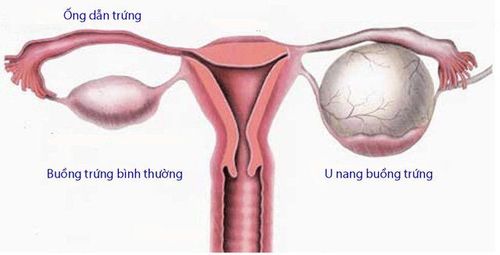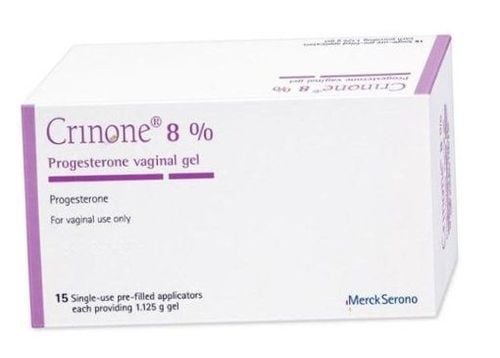This is an automatically translated article.
The article is professionally consulted by Specialist Doctor I Truong Nghia Binh - Specialist in Obstetrics - Obstetrics and Gynecology - Vinmec Da Nang International HospitalThe menstrual cycle is a physiological characteristic of a woman. However, when having ovarian failure, the characteristics of the menstrual cycle will be changed, with menstrual symptoms becoming less frequent, delayed, stopping or disappearing altogether. This seriously affects the ability to have children as well as adverse physical and psychological changes of women.
1. What is primary ovarian failure?
Primary ovarian failure, also known as premature ovarian failure, occurs when a woman's ovaries stop working before the age of 40. The concept of "primary" helps distinguish it from other organ-related causes that adversely affect the ovaries.Normally, most women will lose their fertility after age 40. In addition, they may begin to have irregular periods, with less menstrual bleeding before transitioning to menopause. However, for women with primary ovarian failure, not only are their periods irregular, but their fertility is reduced very early on. Sometimes, the disease is even seen in adolescence.
2. Why do menstrual periods become less frequent in primary ovarian failure?
A long menstrual cycle, a sparse frequency, and a small amount of menstrual blood are typical symptoms of primary ovarian failure. However, in about 90% of cases, the exact cause of ovarian failure is still unknown.
Many studies show that primary ovarian failure is related to the follicles. These are small sacs in the ovary that help nourish the egg and develop it before ovulation. When the follicle is damaged, the egg is difficult to "ripe" and does not create a menstrual cycle.
Other causes are direct effects on the ovaries such as chemotherapy or radiation exposure, toxins such as tobacco smoke, chemicals and pesticides ... or the number of follicles is inherently low. from birth.

3. Who is at risk for primary ovarian failure?
Several factors may increase the risk of primary ovarian failure in women as follows:Family history: Women whose maternal grandmother, mother or sister had primary ovarian insufficiency are more likely to have primary ovarian failure. have this disease; Genetic characteristics: Certain genetic changes and genetic conditions put women at higher risk of primary ovarian failure. For example, women with Fragile X syndrome or Turner syndrome are at higher risk; Having certain medical conditions: Such as autoimmune diseases, viral infections; Having and treating cancer with chemotherapy and radiation therapy; Age: Younger women are still at risk for primary ovarian failure. However, the disease becomes more common between the ages of 35 and 40.
4. What are the symptoms of primary ovarian failure?

In addition, primary ovarian failure has other symptoms similar to natural menopause in a normal woman:
Hot flashes; Night sweats; irritability, anxiety and depression; Poor concentration; Decreased sex drive; Pain during sex; Vaginal dryness; Having cardiovascular diseases; Osteoporosis, weak bones, brittle and more easily broken. However, the most severe symptom for women with primary ovarian failure is difficulty becoming pregnant or infertility. This is the reason why women should see a doctor at a very young age.
5. How is primary ovarian failure diagnosed?
To diagnose primary ovarian insufficiency, your doctor will rely on a thorough medical history, a pregnancy test to make sure you are not pregnant, and a comprehensive examination and gynecology specialist.
At the same time, confirming the diagnosis is also supported by blood tests, which quantify the levels of certain sex hormones. Moreover, chromosomal sequencing is also a way of checking genetic information, detecting abnormalities early before they manifest into phenotypes.
Regarding imaging, the most necessary tool to investigate is pelvic ultrasound to see if the ovaries are complete and have many follicles that develop in the sequence of the menstrual cycle.
6. How is primary ovarian failure treated?
Currently, there is no proven treatment that is absolutely effective in restoring normal ovarian function.However, there are still some methods to treat the symptoms caused by ovarian failure, although it cannot avoid more or less other damage to the body. The methods currently being applied are:
Hormone replacement therapy: This is the most common treatment. This therapy provides the body with the necessary amount of estrogen as well as other hormones that the ovaries cannot make. Not only that, hormone replacement therapy also helps improve sexual health and reduce the risk of cardiovascular disease, osteoporosis; Get regular physical activity and keep a healthy body weight: Active exercise and weight control can also reduce the risk of osteoporosis and heart disease; Calcium and vitamin D supplements: Because women with primary ovarian insufficiency have a higher risk of osteoporosis, they should take more pills or increase their daily consumption of foods rich in calcium and vitamin D; In vitro fertilization: This is a suitable suggestion if a person with primary ovarian failure is diagnosed with infertility, has difficulty conceiving but still wants to get pregnant; Treatment of comorbidities: If a woman has symptoms related to primary ovarian failure, besides investigating local causes, it is necessary to examine and treat general systemic diseases. In short, when you see that your period is less and less progressing through many cycles, this should be considered an alarm symptom, so you should go to the doctor soon and find the cause. If it is due to ovarian failure, it must be treated properly to keep the "physiological nature" of women as well as not to lose the motherhood unfortunately.
Please dial HOTLINE for more information or register for an appointment HERE. Download MyVinmec app to make appointments faster and to manage your bookings easily.














